Heather Graham's Blog, page 4
April 8, 2013
30 Days of Why I Love New Orleans - Zoo - Day 14
The Zoo See these eyes . . . .
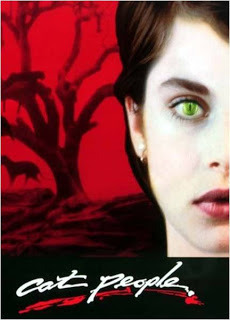 Think back, remember. Let your mind hear the haunting music of a great song by David Bowie. See in your mind’s eye something sleek and black and incredibly graceful . . . a leopard, a black leopard. Cat People—actually, the remake of the 1942 classic, was filmed in NOLA, with much of the filming taking place at the zoo. This one stars the ever wonderful Malcolm McDowell and Natasha Kinski and its considered to be erotic. That’s, of course, because, ahem, falling in love turns the naïve star into a leopard but due to circumstances, our heroine doesn’t know this until she comes to stay with her brother—in New Orleans. And if you’re a leopard, where do you wind up?
Think back, remember. Let your mind hear the haunting music of a great song by David Bowie. See in your mind’s eye something sleek and black and incredibly graceful . . . a leopard, a black leopard. Cat People—actually, the remake of the 1942 classic, was filmed in NOLA, with much of the filming taking place at the zoo. This one stars the ever wonderful Malcolm McDowell and Natasha Kinski and its considered to be erotic. That’s, of course, because, ahem, falling in love turns the naïve star into a leopard but due to circumstances, our heroine doesn’t know this until she comes to stay with her brother—in New Orleans. And if you’re a leopard, where do you wind up?
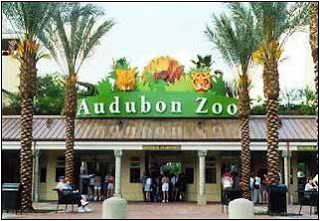 The zoo! (6500 Magazine Street) I love the New Orleans zoo. It isn’t anywhere near as big as some of the zoos I’ve been to, but it’s big enough for a good day of walking if you want to catch all the exhibits. It’s also different, too, because it has an atmosphere that’s somehow entirely New Orleans. And guess what? It consistently ranks among our nation’s top zoos!
The zoo! (6500 Magazine Street) I love the New Orleans zoo. It isn’t anywhere near as big as some of the zoos I’ve been to, but it’s big enough for a good day of walking if you want to catch all the exhibits. It’s also different, too, because it has an atmosphere that’s somehow entirely New Orleans. And guess what? It consistently ranks among our nation’s top zoos!
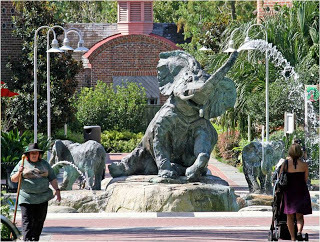 The Audubon Zoo opened in 1938 and in the 1980s it was given a “zoo-over,” naturally to update things and also because that’s about when we realized that animals used to space needed more than little cages and we just started caring a lot more about what we did. We went to “natural” habitats. As with everything else, the “summer of storms” played havoc, but creatures were cared for and this area—not far from Tulane and Loyola—didn’t suffer the way some did. I was recently there; the trees were weaving, flowers—flowering—and fountains bubbling. It was a lovely day. The old mingles beautifully with the new here. I’m a zoo nut. It’s one of the reasons I fell in love with the city as a child. There are magnificent creatures to be seen, and yes, many cities have fine zoos. But if you’re like me, you’ll want to see this one because it is unique and it’s especially fun if you’re traveling with
The Audubon Zoo opened in 1938 and in the 1980s it was given a “zoo-over,” naturally to update things and also because that’s about when we realized that animals used to space needed more than little cages and we just started caring a lot more about what we did. We went to “natural” habitats. As with everything else, the “summer of storms” played havoc, but creatures were cared for and this area—not far from Tulane and Loyola—didn’t suffer the way some did. I was recently there; the trees were weaving, flowers—flowering—and fountains bubbling. It was a lovely day. The old mingles beautifully with the new here. I’m a zoo nut. It’s one of the reasons I fell in love with the city as a child. There are magnificent creatures to be seen, and yes, many cities have fine zoos. But if you’re like me, you’ll want to see this one because it is unique and it’s especially fun if you’re traveling with
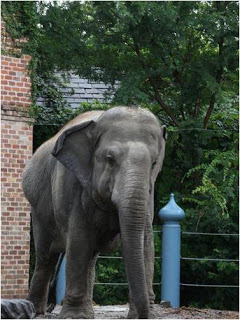 children. It is 58 acres, so you can spend time walking around! There are all kinds of things to do; there’s an elephant plaza and at designated times, a keeper gives an elephant show and children can touch an elephant without paying the extra needed at many zoos for an elephant ride. The elephants, Jean and Panya, are favorites of visitors to the zoo.
children. It is 58 acres, so you can spend time walking around! There are all kinds of things to do; there’s an elephant plaza and at designated times, a keeper gives an elephant show and children can touch an elephant without paying the extra needed at many zoos for an elephant ride. The elephants, Jean and Panya, are favorites of visitors to the zoo.

Sea lions delight crowds and their exhibit is one of the oldest at the zoo. The lovely columns make it an especially pleasant spot and when it’s feeding time, you might need to jockey for space to see the fun.
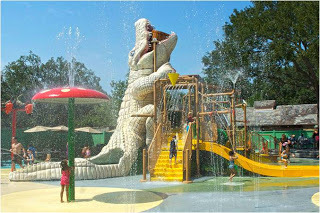
We all know (I mean, realistically, seriously!) New Orleans can get hot. But the zoo takes care of that by having a Cool Zoo. It’s animal themed, of course, but it’s a splash playground that tons of fun—for little children and those big children called grown-ups alike. You’re actually right in Uptown New Orleans—but you can be in the swamp while there, and sit in a rocker, and take in what that life might be like—and cool down a little there, too. Lots of trees and shade. You’re safely up close and safe with lots of alligators as they bask and swim in muddy water
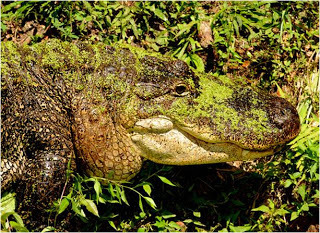 and watch you with their curiously cunning eyes. You’ll also see a Cajun houseboat out on the lagoon, and other denizens of the region. Reptiles? They got ‘em. Cobras, rattlesnakes, Kimodo dragons.
and watch you with their curiously cunning eyes. You’ll also see a Cajun houseboat out on the lagoon, and other denizens of the region. Reptiles? They got ‘em. Cobras, rattlesnakes, Kimodo dragons.
There are white tiger brothers here—King Rex and King Zulu.
 Monkeys, primates, bears. Giraffes? Of course. You’ll find them at the African Savannah along with hippos, rhinos, zebras, wild dogs, and more. Years and years ago, under the Works Progress Administration, workers built Monkey Hill. It’s twenty-eight feet tall; for many children from New Orleans, it’s the only hill they know.
Monkeys, primates, bears. Giraffes? Of course. You’ll find them at the African Savannah along with hippos, rhinos, zebras, wild dogs, and more. Years and years ago, under the Works Progress Administration, workers built Monkey Hill. It’s twenty-eight feet tall; for many children from New Orleans, it’s the only hill they know.
And, of course, it’s legendary for being the highesttopographical point in the city. Today it has trails, wading pool and a cool rope bridge.
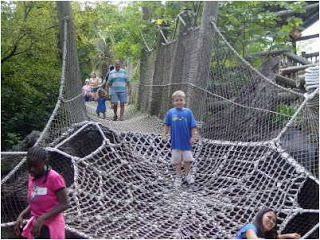 If you haven’t much time and you’re not sure what you want to see most, I suggest you catch the little tram which does a pretty good sweep of the zoo; then you know. Wow—I missed that turn. I have to go see the bear!Naturally, you can stop for a snack, or lunch, or a drink. It’s hot, right? Of course, they have water and sell it, too. There are a few rides, too, if you’re looking for that kind of entertainment—but those are animal themed, too. (Extra fee.)
If you haven’t much time and you’re not sure what you want to see most, I suggest you catch the little tram which does a pretty good sweep of the zoo; then you know. Wow—I missed that turn. I have to go see the bear!Naturally, you can stop for a snack, or lunch, or a drink. It’s hot, right? Of course, they have water and sell it, too. There are a few rides, too, if you’re looking for that kind of entertainment—but those are animal themed, too. (Extra fee.)
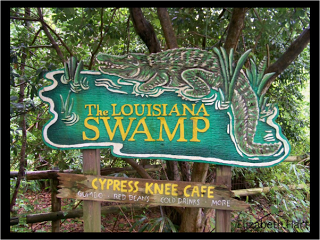 If you haven’t caught the movie, Cat People (I’m referring to the 1982 remake,) it shows some really fine buildings unique to the New Orleans zoo. They were what made the set design so compelling, in my mind. Some have seen the way of storms and time, but some still stand; you can ask at information if you want to know which ones are original to the zoo. People there are friendly and helpful.
If you haven’t caught the movie, Cat People (I’m referring to the 1982 remake,) it shows some really fine buildings unique to the New Orleans zoo. They were what made the set design so compelling, in my mind. Some have seen the way of storms and time, but some still stand; you can ask at information if you want to know which ones are original to the zoo. People there are friendly and helpful.
 Did I mention the jaguars? They can be found at Jaguar Jungle. They live in a habitat created to resemble Mayan ruins. You'll also find anteaters there, along with sloths, spider monkeys and other creatures. The different habitats are well done and reflect the natural homes of the animals.
Did I mention the jaguars? They can be found at Jaguar Jungle. They live in a habitat created to resemble Mayan ruins. You'll also find anteaters there, along with sloths, spider monkeys and other creatures. The different habitats are well done and reflect the natural homes of the animals.
All in all, it’s a lovely day in a beautiful section of the city. They take excellent care of the animals and all the trainers and keepers I met were deeply devoted to their charges. They do close around four or five in the afternoon, depending on the day, and if you’ve driven there, when you’re done, you can take a ride down Magazine Street where you’ll find wonderful restaurants and stores and you can browse and find a great place for dinner. For many of my friends who live in the city, Magazine is their favorite place to shop. I’m rather partial to a few places there myself.But I love the zoo. There’s something very special about it.Cats, yes, of course, big cats!
 See these eyes . . . .
See these eyes . . . .
 Think back, remember. Let your mind hear the haunting music of a great song by David Bowie. See in your mind’s eye something sleek and black and incredibly graceful . . . a leopard, a black leopard. Cat People—actually, the remake of the 1942 classic, was filmed in NOLA, with much of the filming taking place at the zoo. This one stars the ever wonderful Malcolm McDowell and Natasha Kinski and its considered to be erotic. That’s, of course, because, ahem, falling in love turns the naïve star into a leopard but due to circumstances, our heroine doesn’t know this until she comes to stay with her brother—in New Orleans. And if you’re a leopard, where do you wind up?
Think back, remember. Let your mind hear the haunting music of a great song by David Bowie. See in your mind’s eye something sleek and black and incredibly graceful . . . a leopard, a black leopard. Cat People—actually, the remake of the 1942 classic, was filmed in NOLA, with much of the filming taking place at the zoo. This one stars the ever wonderful Malcolm McDowell and Natasha Kinski and its considered to be erotic. That’s, of course, because, ahem, falling in love turns the naïve star into a leopard but due to circumstances, our heroine doesn’t know this until she comes to stay with her brother—in New Orleans. And if you’re a leopard, where do you wind up? The zoo! (6500 Magazine Street) I love the New Orleans zoo. It isn’t anywhere near as big as some of the zoos I’ve been to, but it’s big enough for a good day of walking if you want to catch all the exhibits. It’s also different, too, because it has an atmosphere that’s somehow entirely New Orleans. And guess what? It consistently ranks among our nation’s top zoos!
The zoo! (6500 Magazine Street) I love the New Orleans zoo. It isn’t anywhere near as big as some of the zoos I’ve been to, but it’s big enough for a good day of walking if you want to catch all the exhibits. It’s also different, too, because it has an atmosphere that’s somehow entirely New Orleans. And guess what? It consistently ranks among our nation’s top zoos!  The Audubon Zoo opened in 1938 and in the 1980s it was given a “zoo-over,” naturally to update things and also because that’s about when we realized that animals used to space needed more than little cages and we just started caring a lot more about what we did. We went to “natural” habitats. As with everything else, the “summer of storms” played havoc, but creatures were cared for and this area—not far from Tulane and Loyola—didn’t suffer the way some did. I was recently there; the trees were weaving, flowers—flowering—and fountains bubbling. It was a lovely day. The old mingles beautifully with the new here. I’m a zoo nut. It’s one of the reasons I fell in love with the city as a child. There are magnificent creatures to be seen, and yes, many cities have fine zoos. But if you’re like me, you’ll want to see this one because it is unique and it’s especially fun if you’re traveling with
The Audubon Zoo opened in 1938 and in the 1980s it was given a “zoo-over,” naturally to update things and also because that’s about when we realized that animals used to space needed more than little cages and we just started caring a lot more about what we did. We went to “natural” habitats. As with everything else, the “summer of storms” played havoc, but creatures were cared for and this area—not far from Tulane and Loyola—didn’t suffer the way some did. I was recently there; the trees were weaving, flowers—flowering—and fountains bubbling. It was a lovely day. The old mingles beautifully with the new here. I’m a zoo nut. It’s one of the reasons I fell in love with the city as a child. There are magnificent creatures to be seen, and yes, many cities have fine zoos. But if you’re like me, you’ll want to see this one because it is unique and it’s especially fun if you’re traveling with  children. It is 58 acres, so you can spend time walking around! There are all kinds of things to do; there’s an elephant plaza and at designated times, a keeper gives an elephant show and children can touch an elephant without paying the extra needed at many zoos for an elephant ride. The elephants, Jean and Panya, are favorites of visitors to the zoo.
children. It is 58 acres, so you can spend time walking around! There are all kinds of things to do; there’s an elephant plaza and at designated times, a keeper gives an elephant show and children can touch an elephant without paying the extra needed at many zoos for an elephant ride. The elephants, Jean and Panya, are favorites of visitors to the zoo. 
Sea lions delight crowds and their exhibit is one of the oldest at the zoo. The lovely columns make it an especially pleasant spot and when it’s feeding time, you might need to jockey for space to see the fun.

We all know (I mean, realistically, seriously!) New Orleans can get hot. But the zoo takes care of that by having a Cool Zoo. It’s animal themed, of course, but it’s a splash playground that tons of fun—for little children and those big children called grown-ups alike. You’re actually right in Uptown New Orleans—but you can be in the swamp while there, and sit in a rocker, and take in what that life might be like—and cool down a little there, too. Lots of trees and shade. You’re safely up close and safe with lots of alligators as they bask and swim in muddy water
 and watch you with their curiously cunning eyes. You’ll also see a Cajun houseboat out on the lagoon, and other denizens of the region. Reptiles? They got ‘em. Cobras, rattlesnakes, Kimodo dragons.
and watch you with their curiously cunning eyes. You’ll also see a Cajun houseboat out on the lagoon, and other denizens of the region. Reptiles? They got ‘em. Cobras, rattlesnakes, Kimodo dragons. There are white tiger brothers here—King Rex and King Zulu.
 Monkeys, primates, bears. Giraffes? Of course. You’ll find them at the African Savannah along with hippos, rhinos, zebras, wild dogs, and more. Years and years ago, under the Works Progress Administration, workers built Monkey Hill. It’s twenty-eight feet tall; for many children from New Orleans, it’s the only hill they know.
Monkeys, primates, bears. Giraffes? Of course. You’ll find them at the African Savannah along with hippos, rhinos, zebras, wild dogs, and more. Years and years ago, under the Works Progress Administration, workers built Monkey Hill. It’s twenty-eight feet tall; for many children from New Orleans, it’s the only hill they know. And, of course, it’s legendary for being the highesttopographical point in the city. Today it has trails, wading pool and a cool rope bridge.
 If you haven’t much time and you’re not sure what you want to see most, I suggest you catch the little tram which does a pretty good sweep of the zoo; then you know. Wow—I missed that turn. I have to go see the bear!Naturally, you can stop for a snack, or lunch, or a drink. It’s hot, right? Of course, they have water and sell it, too. There are a few rides, too, if you’re looking for that kind of entertainment—but those are animal themed, too. (Extra fee.)
If you haven’t much time and you’re not sure what you want to see most, I suggest you catch the little tram which does a pretty good sweep of the zoo; then you know. Wow—I missed that turn. I have to go see the bear!Naturally, you can stop for a snack, or lunch, or a drink. It’s hot, right? Of course, they have water and sell it, too. There are a few rides, too, if you’re looking for that kind of entertainment—but those are animal themed, too. (Extra fee.) If you haven’t caught the movie, Cat People (I’m referring to the 1982 remake,) it shows some really fine buildings unique to the New Orleans zoo. They were what made the set design so compelling, in my mind. Some have seen the way of storms and time, but some still stand; you can ask at information if you want to know which ones are original to the zoo. People there are friendly and helpful.
If you haven’t caught the movie, Cat People (I’m referring to the 1982 remake,) it shows some really fine buildings unique to the New Orleans zoo. They were what made the set design so compelling, in my mind. Some have seen the way of storms and time, but some still stand; you can ask at information if you want to know which ones are original to the zoo. People there are friendly and helpful.  Did I mention the jaguars? They can be found at Jaguar Jungle. They live in a habitat created to resemble Mayan ruins. You'll also find anteaters there, along with sloths, spider monkeys and other creatures. The different habitats are well done and reflect the natural homes of the animals.
Did I mention the jaguars? They can be found at Jaguar Jungle. They live in a habitat created to resemble Mayan ruins. You'll also find anteaters there, along with sloths, spider monkeys and other creatures. The different habitats are well done and reflect the natural homes of the animals.All in all, it’s a lovely day in a beautiful section of the city. They take excellent care of the animals and all the trainers and keepers I met were deeply devoted to their charges. They do close around four or five in the afternoon, depending on the day, and if you’ve driven there, when you’re done, you can take a ride down Magazine Street where you’ll find wonderful restaurants and stores and you can browse and find a great place for dinner. For many of my friends who live in the city, Magazine is their favorite place to shop. I’m rather partial to a few places there myself.But I love the zoo. There’s something very special about it.Cats, yes, of course, big cats!
 See these eyes . . . .
See these eyes . . . .
Published on April 08, 2013 07:16
April 6, 2013
30 Days of Why I Love New Orleans - Day 13
Lower Mississippi Plantations
Many of these plantations help explain a statistic—in 1850, it’s estimated that almost 2/3 of our country’s millionaires lived along the Great River Road here in Louisiana.
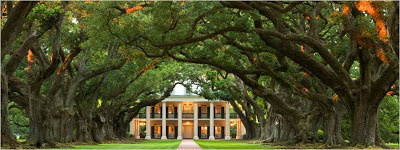 Naturally, the plantations are broken up into Upper and Lower because you’ll be going in two different directions from NOLA to visit each set of plantations.
Naturally, the plantations are broken up into Upper and Lower because you’ll be going in two different directions from NOLA to visit each set of plantations. I’m going to start out with one I love and where I’ve stayed overnight--Oak Alley. (3645 Highway 18, Vacherie)
The very name conjures up a view most of us have seen at some time in our lives—the sweeping line of oaks that leads to the grand plantation.
Oak Alley is grand on just about every scale. Naturally, it’s impressive just to approach the mansion—there are 28 towering oaks that are estimated to be over three hundred years old.
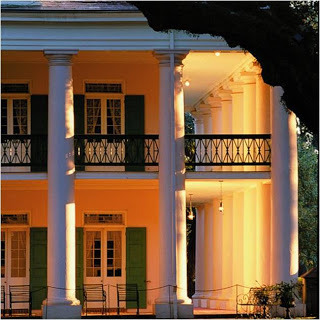 They lead to and create a frame for the entrance to the mansion.
They lead to and create a frame for the entrance to the mansion. The plantation itself is a star—it’s been used in numerous movies and television shows including Interview With a Vampire, The Long Hot Summer, and many more. It looks like one of the grand estates seen in Gone With the Wind, but that exterior was actually filmed elsewhere. The house was built in 1837 (for Jacques Telephore Roman III) and conjures up images of fine carriages and women in sweeping antebellum gowns. There are massive columns and a second floor gallery. But there is much more to see here than just the house—which is beautifully kept with period pieces and décor. Not that a tour of the house isn’t filled with wondrous sites and the guides tell the history exceptionally well.
But here, you can also visit a Civil War campsite, see restored outbuildings, and also see an
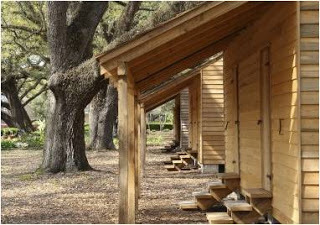 excellent slave quarters exhibit. There’s a blacksmith’s shop and other buildings pertinent to the day to day running of a plantation with all the work that was involved. There are gardens, gravestones, and a gift shop, naturally. At Oak Alley, you can really get beneath the beauty—though that is abundant—and get down to daily basics and all that went into running these massive estates. (The forge is original!)
excellent slave quarters exhibit. There’s a blacksmith’s shop and other buildings pertinent to the day to day running of a plantation with all the work that was involved. There are gardens, gravestones, and a gift shop, naturally. At Oak Alley, you can really get beneath the beauty—though that is abundant—and get down to daily basics and all that went into running these massive estates. (The forge is original!) We stayed here with a group in one of the outbuildings; we were a fairly large group so we actually had a little “house” to ourselves. It’s beautiful to be here at night, to see the oaks as twilight falls, and to discover all the grounds have to offer. I also love the restaurant—let me mention again that the shrimp po-boy is delicious. When you come, you’ll naturally be regaled with tales as well about the local haunts and when you see mist fall over the oaks, you’ll believe you see fine gentlemen
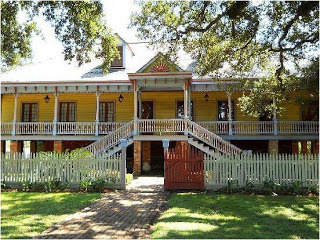 and elegant ladies strolling along them.
and elegant ladies strolling along them. Just down the street is Laura. (2247 Highway 18) This is a classic raised Creole plantation and it was built by Guillame Duparc, a Revolutionary War veteran in 1805. It’s really interesting to visit Laura right after exploring Oak Alley—you get a sense of the difference of the classic English/American plantation and the Creole plantation. Something very fun for me in the grand scheme of wonderful stories we hear as children is the literary tradition that was born here; the slaves told stories. The original French was translated by folklorist Alcee Fortier and later became Joel Chandler Harris’s tales found in the Uncle Remus and
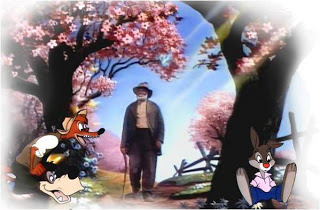 Brer Rabbit books. Now, every time I’m at Disney going on Splash Mountain, I think of Laura! Like many places, Laura was devastated by a fire but it’s been excellently restored to show true Creole style. As always, look Laura up before going and check out hours and appointment times for tours.
Brer Rabbit books. Now, every time I’m at Disney going on Splash Mountain, I think of Laura! Like many places, Laura was devastated by a fire but it’s been excellently restored to show true Creole style. As always, look Laura up before going and check out hours and appointment times for tours. On to Nottoway, again, grand and wonderful—and I especially love it because of the name. It literally came to the time of building when it was being constructed in 1859. The architect was Henry Howard and John Randolph was going to be moving in with
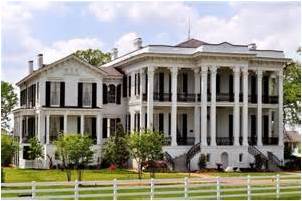 his wife and eleven children and it was meant to be a mansion. Therefore, only the finest wood could be used—not the pieces with knots. So, the cry went up—“Knot away!” And thus, goes the legend, the house—the largest on the stretch of River Road. Okay, big. I mean big. 53,000 square feet, 64 rooms. There are fireplaces galore, beautiful windows, antiques, wonderful things that display the life of the, ahem, really well-to-do.
his wife and eleven children and it was meant to be a mansion. Therefore, only the finest wood could be used—not the pieces with knots. So, the cry went up—“Knot away!” And thus, goes the legend, the house—the largest on the stretch of River Road. Okay, big. I mean big. 53,000 square feet, 64 rooms. There are fireplaces galore, beautiful windows, antiques, wonderful things that display the life of the, ahem, really well-to-do. Nottoway might have been a victim of the Civil War, however, when a Union gunboat was bearing down, one of her officers asked the house be spared—once upon a time, he’d been a
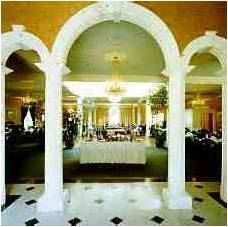 guest there and he couldn’t bear to see the home destroyed. (30970 Highway 405, White Castle)
guest there and he couldn’t bear to see the home destroyed. (30970 Highway 405, White Castle) I really (really, really, really!) suggest you see this plantation. It’s truly one of our finest examples of antebellum architecture.
Destrehan (13034 River Road) was built by a “free man of color.” It was built in the Creole
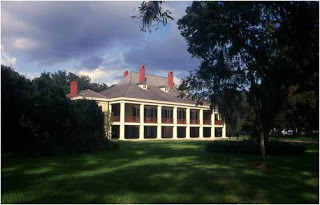 style in 1787 but then modified in 1830-1840. A historical note here is that Union soldiers freed the slaves working here when they came through during the Civil War. Sugar drove the economy here, and there are several buildings to be seen.
style in 1787 but then modified in 1830-1840. A historical note here is that Union soldiers freed the slaves working here when they came through during the Civil War. Sugar drove the economy here, and there are several buildings to be seen. 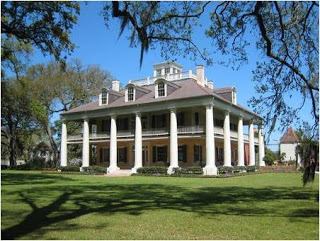 Houmas House, dating from 1840, survived the Civil War because its owner, John Burnside, was Irish. He demanded that he be treated as a British subject, and therefore, he’d best be left alone. (40136 Highway 942, Darrow. He grew sugar cane and had a number of sugar mills. The house is grand with galleries and columns and if you're out in that direction, you should also stop in nearby Houma, Louisiana. There you’ll find one of the finest independent book stores still going strong in our country. That’s because it’s run by Molly and Kay who know their readers, know their books, and are it's one of the most friendly places you’ll ever find.
Houmas House, dating from 1840, survived the Civil War because its owner, John Burnside, was Irish. He demanded that he be treated as a British subject, and therefore, he’d best be left alone. (40136 Highway 942, Darrow. He grew sugar cane and had a number of sugar mills. The house is grand with galleries and columns and if you're out in that direction, you should also stop in nearby Houma, Louisiana. There you’ll find one of the finest independent book stores still going strong in our country. That’s because it’s run by Molly and Kay who know their readers, know their books, and are it's one of the most friendly places you’ll ever find. 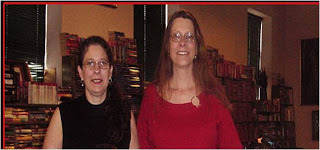
To round out this group of exceptionally fine and historic plantations, you can hop on over to Madewood in Napoleonville at 4350 Highway 308. It, too, was erected for a sugar planter between 1840 and 1848 and is considered to be the first building of note by architect Henry
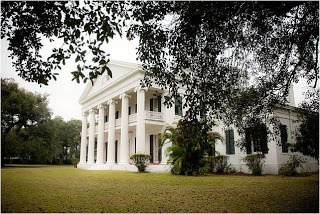 Howard. It’s a bed and breakfast, the nicest, most hospitable kind, and yes . . . you can rent it for events! Louisiana is famed for its gracious grand plantations—venues that teach us about a past that was considered romantically slow and graceful—except that, of course, these days, they teach you all that is good and not so good about history. But here’s the thing, remember—knowing we behaved badly doesn’t change history. It should never be white-washed. So see these grand places to appreciate—and to remember! We continue daily to fight for true equality for everyone, no matter what their color—or religion, sex, sexual orientation, or ethnicity!
Howard. It’s a bed and breakfast, the nicest, most hospitable kind, and yes . . . you can rent it for events! Louisiana is famed for its gracious grand plantations—venues that teach us about a past that was considered romantically slow and graceful—except that, of course, these days, they teach you all that is good and not so good about history. But here’s the thing, remember—knowing we behaved badly doesn’t change history. It should never be white-washed. So see these grand places to appreciate—and to remember! We continue daily to fight for true equality for everyone, no matter what their color—or religion, sex, sexual orientation, or ethnicity!
Published on April 06, 2013 00:05
April 5, 2013
30 Days of Why I Love New Orleans - Day 12
More Plantations!
Some of the most beautiful and/or intriguing plantations you’ll ever see can be found in Louisiana, and while I’ve spent the most time at the Myrtles, there are others, some smaller, some larger, each with their own little piece of history in the greater scale of things.
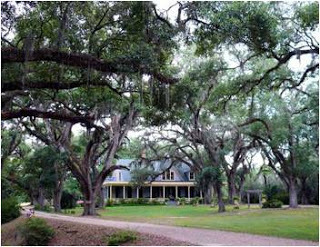 Remember, plantation means farm, so some are huge, others are modest, but all have something special.
Remember, plantation means farm, so some are huge, others are modest, but all have something special. The Myrtles is an Upper Mississippi plantation, so we’ll look at a few more of those plantations today.
Just down the road at 8345 Highway 61 (St. Francisville) is Butler Greenwood Plantation—a bed and breakfast. Butler Greenwood is remarkable for the fact that the plantation has stayed in the same family throughout the years. It was built by a Pennsylvania Quaker, Doctor Samuel Flower, in 1796 as a cotton plantation. Harriet, the good doctor’s daughter, continued to run the home and grounds as a cotton plantation during most of the following century—until her death. But the family picked up the reins. The plantation is still producing cotton—but now it’s open to the public.
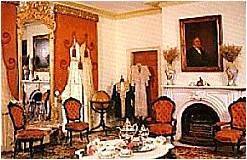
It’s furnished with wonderful antebellum pieces and has an absolutely gorgeous stairway that is a must-see to me. Another must-see is the twelve piece parlor set all made of rosewood.
Cast iron benches adorn the grounds which are enchanting.
Something else special—there are family portraits to be seen throughout the house. It’s fun to wonder about the men and women who went before and lived and breathed in the house and called it home.
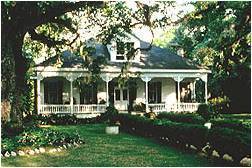 Okay, frankly, Highway 61 can be a great ride in itself, just going from plantation to plantation. Next, we’ll mention Catalpa (9508 Highway 61.) The house is a reconstruction; the original was destroyed by fire in 1885. But it was first built by William J. Fort in the early 1800s—he was a man famous for his charm and for welcoming visitors into his home. The reconstruction is lovely and the grounds well worth a visit.
Okay, frankly, Highway 61 can be a great ride in itself, just going from plantation to plantation. Next, we’ll mention Catalpa (9508 Highway 61.) The house is a reconstruction; the original was destroyed by fire in 1885. But it was first built by William J. Fort in the early 1800s—he was a man famous for his charm and for welcoming visitors into his home. The reconstruction is lovely and the grounds well worth a visit. Not to be confused with Butler Greenwood Plantation is Greenwood Plantation, also on Highway 61. (Pretty sure that we average tourists can’t just do the river-drop-by anymore!) Greenwood is one of the largest of what
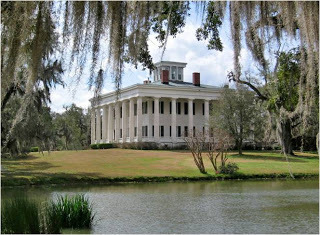 they call the “American-style” plantations. It’s majestic—truly beautiful when seen just as one approaches. The Greek Revival home was built for William Ruffin Barrow. At one time, there were forty plus outbuildings for all kinds of work, making the home entirely self-sufficient. Mr. Barrow must have been one smart cookie—he anticipated that no matter what anyone’s “Cause,” the Civil War was going to wreak havoc on the South and he sold out. The plantation became a hospital and after that, well, as Mr. Barrow had surmised, it began to fall apart.
they call the “American-style” plantations. It’s majestic—truly beautiful when seen just as one approaches. The Greek Revival home was built for William Ruffin Barrow. At one time, there were forty plus outbuildings for all kinds of work, making the home entirely self-sufficient. Mr. Barrow must have been one smart cookie—he anticipated that no matter what anyone’s “Cause,” the Civil War was going to wreak havoc on the South and he sold out. The plantation became a hospital and after that, well, as Mr. Barrow had surmised, it began to fall apart. 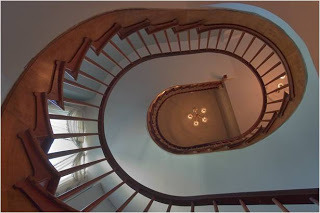 Restored in 1906, it too became victim to a fire, but the grand columns remained and (28 Doric columns, awesome!) and once again, Greenwood was restored. It’s also a bed and breakfast and—you guessed it—lots of people seem to want to get married at such a beautiful place.
Restored in 1906, it too became victim to a fire, but the grand columns remained and (28 Doric columns, awesome!) and once again, Greenwood was restored. It’s also a bed and breakfast and—you guessed it—lots of people seem to want to get married at such a beautiful place. Cottage Plantation is also in St. Francisville, and it can be found at 10528 Cottage Lane (still really easy!) There’s some real history here; Judge Thomas Butler—the son of Colonel Thomas Butler, one famed for being part of the “Fighting Butlers” who served beneath General George Washington. The house is truly beautiful—inside you’ll find gold-leaf wallpaper and all kinds of exquisite and
 historic bric-a-brac. The proper includes many outbuildings, including slave cabins and others, and a restaurant. Of course, accommodations are offered!
historic bric-a-brac. The proper includes many outbuildings, including slave cabins and others, and a restaurant. Of course, accommodations are offered! At 12501 Highway 10, you’ll find Rosedown Plantation. It’s big, it’s wonderful. Cedar and cypress create a gabled central structure and massive Doric columns support a double gallery, or wonderful porches that look out over the grounds. This plantation was owned by the Turnbull family
 from about 1835 to 1855 and what’s wonderful about that was Mrs. Turnbull—she was a horticulturalist and she is known to have brought to the area the first azaleas and camellias. This means that there are acres and acres of beautiful gardens to be seen here. The State of Louisiana now owns the plantation and has taken loving care of it—restoring what was lost when the previous owner sold off some of what had been original. A tour takes about forty-five or fifty minutes.
from about 1835 to 1855 and what’s wonderful about that was Mrs. Turnbull—she was a horticulturalist and she is known to have brought to the area the first azaleas and camellias. This means that there are acres and acres of beautiful gardens to be seen here. The State of Louisiana now owns the plantation and has taken loving care of it—restoring what was lost when the previous owner sold off some of what had been original. A tour takes about forty-five or fifty minutes. While in St. Francisville—now at Highway 965—you can also stop in and see Oakley House an Audubon State Historic Site. (Great thing about Audubon—the man did get around!) The house was built by a wealthy Scotsman, James Pirrie, between 1808 and 1810. In 1821, James Audubon came to the house to teach the young lady of the manor. He wasn’t there that long—a few months; seemed he and the wealthy Scotsman didn’t get along that well. But, while he was there, he painted many of his images of birds
 that later appeared in Birds of America. You can go and see the study where he worked, and, naturally, you can see gardens and . . . birds.
that later appeared in Birds of America. You can go and see the study where he worked, and, naturally, you can see gardens and . . . birds. As you can see, there are all kinds of wonders here to choose from. It depends what you’re looking for. Quiet and beauty and serenity and a sense of the past, or gardens and trees and the richness of nature. Some of the houses can be toured easily, and some are places where you’re going to want to stay. There’s something magical about waking up a plantation that’s now a bed and breakfast. Sometimes, you want what’s real and oldest, sometimes you want what’s biggest and grandest.
Sometimes, you want it all.
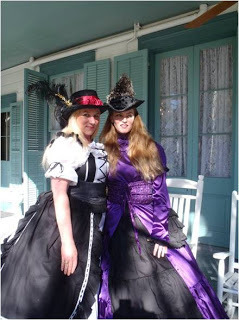 If you start out bright and early, I’d still suggest finding the one that appeals to you most and checking in on any of their web sites about what they offer and what their prices are for whatever season you’re traveling. We’re all different in what we love, like, and really don’t care about at all. I’d find it hard, though, not to be intrigued in some way.
If you start out bright and early, I’d still suggest finding the one that appeals to you most and checking in on any of their web sites about what they offer and what their prices are for whatever season you’re traveling. We’re all different in what we love, like, and really don’t care about at all. I’d find it hard, though, not to be intrigued in some way. And these are just the plantations of the Upper Mississipi!
Tomorrow . . . the Lower Mississippi Plantations! (Those include the famous and glorious Oak Alley, the Creole plantation, Laura, Nottaway, and the unique San Francisco!
Published on April 05, 2013 11:15
30 Days of Why I Love New Orleans - Day 11
The Myrtles (Day trip 1 from NOLA!) While I’ll cover more plantations tomorrow, I’m going to start with the Myrtles; a plantation in St. Francisville, Louisiana, near and dear to my heart.
 We all know that authors do whacky things for promo and that book trailers are all the rage now. To introduce the Krewe of Hunters series, we decided to do a trailer at a plantation. A haunted plantation, of course. My friends, the Peace River Ghost Hunters, were also able to come up to do a “ghost expedition.” All these things collided in a wonderful weekend at the plantation.
We all know that authors do whacky things for promo and that book trailers are all the rage now. To introduce the Krewe of Hunters series, we decided to do a trailer at a plantation. A haunted plantation, of course. My friends, the Peace River Ghost Hunters, were also able to come up to do a “ghost expedition.” All these things collided in a wonderful weekend at the plantation.
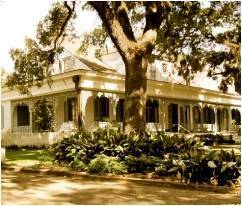 To film we had to have the crew, Bridget from the PR company, and family and friends who were willing to play ghosts, the good, the bad, and the ugly.
To film we had to have the crew, Bridget from the PR company, and family and friends who were willing to play ghosts, the good, the bad, and the ugly.So, I’m going to back track now. “Plantation” as a word really refers to a farm. We’ll get to more of that tomorrow when we do big, little, grand, and mostly work farm.
The Myrtles is beautiful. It’s not the biggest or the grandest, but it’s on that scale.
Building on the plantation was first begun in 1796. Judge David Bradford—a leader of the Whiskey Rebellion in Pennsylvania—fled south to this beautiful spot in Louisiana and built the north wing of the house. It the early 1800s,
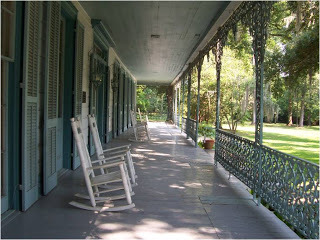 his daughter and her husband added a “gallery”—a first level porch that runs 107 feet. When the sun is falling and dusk is coming, it’s an especially lovely place to sit and enjoy one of the rockers kept there. The house was sold again in 1834 and the south wing was added on.
his daughter and her husband added a “gallery”—a first level porch that runs 107 feet. When the sun is falling and dusk is coming, it’s an especially lovely place to sit and enjoy one of the rockers kept there. The house was sold again in 1834 and the south wing was added on.Needless to say, in the two centuries-plus since the house was built, there has been war and calamity and mayhem—and murder. The Myrtles oozes with ghost stories. Whether you decide to go and stay and just stop and explore, you can take a few tours. One, see the house. Two, wait until the daylight is gone and listen to all the tales about the ghosts.
Staying here is an absolutely charming thing to do—whether you are or aren’t into ghosts. The house and the grounds are lovely. The house is filled with antique treasures from furniture to decoration and standing in the midst of it all, you can get a real feel for antebellum life in this gracious mansion.
There’s a full service restaurant right there, too, if you want to take a tour and stop for a bite to eat. The restaurant is the Carriage House, and everything I ate there was wonderful.
The Myrtles can be taken for weddings, receptions, and other parties—or rented by crazy authors to create book promo videos!
I started off with Dennis, my husband, in the Judge Clarke Woodruff Suite. It’s upstairs above the foyer in the main house and you reach it by a handsome staircase. That’s the only room that allows you access to the foyer after the tours are over for the day. There’s
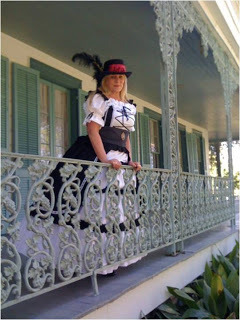 an extra bed in a passage room there, and a private bath and it’s really nice.
an extra bed in a passage room there, and a private bath and it’s really nice.It’s grand and sweeping, and really wonderful and I loved it. It’s truly a suite—and if you take it, that space is all yours! But—if you happen to be of the cowardly persuasion--it’s lonely, too. So, when dusk fell and darkness swept around, I really thought about that. Just the two of us . . . that whole upper floor. And Dennis is well aware that I’m afraid of anything that goes bump in the night.
I wound up spending most of my time on the ground floor, in with Connie and my daughter, Bryee-Annon, in the General David Bradford Suite. It has a sitting room and two of the verandahs adjoin the suite. It’s gorgeous. Hey, the costumes were all down there. And there’s safety in numbers, the way I see it!
There are four more rooms available in the main house, and then more rooms and cottages and even two bedroom facilities available, too. No matter where you stay, the view is beautiful. And the tour is charming and enlightening and really takes you back to a different era—even understanding that a lot of work with trying to appear so elegant and as if you didn’t work! The ghost stories we heard were both chilling and sad. I won’t give those
 away—you’ll have to get to the Myrtles.
away—you’ll have to get to the Myrtles. Of course, we were there to work. There was costuming, and filming, and lots of fun involved. And then Scott and Sprout and the Peace River Ghost Hunters went to work. Now I love them because they’re never out to prove something is haunted—they’re quick to tell you when you’re seeing a shadow or when a thump, thump, thump is just someone’s phone on vibrate. They take pictures; they record, and they leave cameras for when the house is quiet and all are sleeping to see what appears in the wee hours. All I know is that at one point, I’m sure I did hear something. Am I impressionable? Yes. But, writing books and doing the amount of things I do in pursuit of them, I am a skeptic. I want to know why a ghost would haunt a property.
Well, there are many reasons at the Myrtles!
The Myrtles is one of the Upper Mississippi River plantations. It’s at 7747 Highway 61, St. Francisville, Louisiana, about two hours from NOLA. Just hop I-10 There’s a gorgeous brick courtyard for sitting and reading, enjoying coffee, a soft drink, or a cocktail. A gazebo looks over a lake and there’s an absolutely charming bridge there—and ten acres to roam filled with towering oaks.
The owner and the management are friendly and helpful—it’s like a lovely past-life home away from home, a wonderful place to go to find history, peace, tranquility, beauty—and maybe a ghost or two!
I'm very proud of the film we did during our stay at the Myrtles. Let me present The Krewe of Hunter Series.
Published on April 05, 2013 05:51
April 4, 2013
30 Days of Why I Love New Orleans - Day 10
Meet Suzie Q and the NOLA of Anne Rice
One of the best things about the city of New Orleans for me has been people! In the time I’ve spent there I’ve been lucky enough to meet some of the most intriguing and talented people in the world—and people who love the city, the culture, and bring it to others.
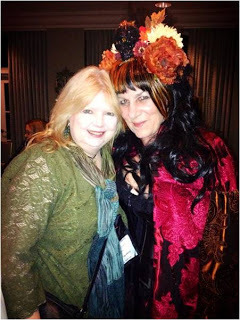 Suzie Quiroz is delightful—and has done something special in the city for years now. If you come at Halloween, there are a variety of things to do and amazing balls to go to. But Suzie introduced a very special ball years ago and it continues to grow. Now, she also does a writer’s con to go with it and pulls in some of the top names in the business. So, I’d like you to meet Suzie Q. And if you’ve a hankering to go to NOLA in October, she has a very special treat set up for 2013.
Suzie Quiroz is delightful—and has done something special in the city for years now. If you come at Halloween, there are a variety of things to do and amazing balls to go to. But Suzie introduced a very special ball years ago and it continues to grow. Now, she also does a writer’s con to go with it and pulls in some of the top names in the business. So, I’d like you to meet Suzie Q. And if you’ve a hankering to go to NOLA in October, she has a very special treat set up for 2013.I’ll let her explain in her own words. (Mostly!)
H: Suzie, you're a master at the city! I've been to your balland con and both are wonderful. (Suzie's NOLA HalloweenBall is legendary!) When did you first come to NOLA?
S: I came to NOLA when I was 13 years old. My mom was born in N.O. and grew up in the Irish Channel. She met my dad during the war when he was in N.O. before he went to Korea. My dad was born in Lancanster, Ohio. My brothers and sister and I were born there, and Melanie was born in
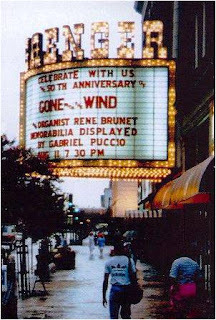 N.O. Coming from a small town, I thought N.O. was huge. I saw my first movie at the Saenger Theatre with my cousin Cindy after my first ride on the streetcar. The movie was Love Me Tender with Elvis. I was in heaven! H: You were Anne Rice's assistant for years. What was that like--and is that how you got into doing your wonderful ball?
N.O. Coming from a small town, I thought N.O. was huge. I saw my first movie at the Saenger Theatre with my cousin Cindy after my first ride on the streetcar. The movie was Love Me Tender with Elvis. I was in heaven! H: You were Anne Rice's assistant for years. What was that like--and is that how you got into doing your wonderful ball?S: My sister Melanie said I had to read Interview with the Vampire and The Vampire Lestat. I met Anne Rice at the Queen of the Damned booksigning in Oct. 1988. Melanie Scott, Susie Miller, Teresa Simmons and I asked her if we could start a fan club for her. She said Lestat would love to have a fan club so we got about 35 people signed up. Anne invited us over to her house and we were given some names to call. It was usually me who would call when we needed things to print. When I lost my job at
 a law firm, I asked Anne if she needed a secretary so that is how I got the job. It was the greatest job because I never knew what I would be doing. It was very challenging. One day when she was on tour she called with my assignment. Pack some clothes and catch a plane to meet her in DC for the Memnoch book tour. I did the bus tour too for Servant of the Bones. In 2000, the fan club ended and in 2002 I started holding the Ball again with my own funds. Things went well and Anne came to the Ball again in 2004. Then Stan was diagnosed with cancer. After Stan's death, Anne moved to CA to be closer to Christopher and I was out of a job. Katrina hit soon after that and I had to start over. When I finally found a place to stay and had access to a computer again, I restarted the fan club so I could afford to hold the Ball in 2006. It has grown since then with authors like Charlaine Harris and Laurell K. Hamilton coming to be the Queen of the Ball. Then in 2010 I wanted to expand and have authors come to take part in panels to talk about their books, to tell us how they got started and about publishing in general. The first year, Heather Graham, Dacre Stoker and
a law firm, I asked Anne if she needed a secretary so that is how I got the job. It was the greatest job because I never knew what I would be doing. It was very challenging. One day when she was on tour she called with my assignment. Pack some clothes and catch a plane to meet her in DC for the Memnoch book tour. I did the bus tour too for Servant of the Bones. In 2000, the fan club ended and in 2002 I started holding the Ball again with my own funds. Things went well and Anne came to the Ball again in 2004. Then Stan was diagnosed with cancer. After Stan's death, Anne moved to CA to be closer to Christopher and I was out of a job. Katrina hit soon after that and I had to start over. When I finally found a place to stay and had access to a computer again, I restarted the fan club so I could afford to hold the Ball in 2006. It has grown since then with authors like Charlaine Harris and Laurell K. Hamilton coming to be the Queen of the Ball. Then in 2010 I wanted to expand and have authors come to take part in panels to talk about their books, to tell us how they got started and about publishing in general. The first year, Heather Graham, Dacre Stoker and 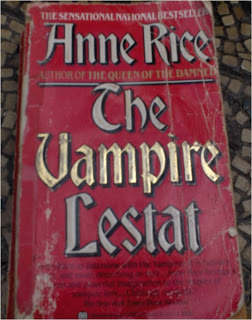 Gabrielle Faust were my headliners and each year we added more authors to our panels like Sherrilyn Kenyon last year. There are many stories of my job that were so memorable, and I guess you could say for 15 years, I was in my dream job. I learned so much from Anne and traveled all over the world. I cannot thank her enough so it was just logical for me to continue the fan club and expand it into a way to bring more people to New Orleans. And all who sit in the panels get to know the authors whose books line the shelves of the book store. These authors who aren't yet as well known as the top NY Times best sellers, will be better known when they leave.
Gabrielle Faust were my headliners and each year we added more authors to our panels like Sherrilyn Kenyon last year. There are many stories of my job that were so memorable, and I guess you could say for 15 years, I was in my dream job. I learned so much from Anne and traveled all over the world. I cannot thank her enough so it was just logical for me to continue the fan club and expand it into a way to bring more people to New Orleans. And all who sit in the panels get to know the authors whose books line the shelves of the book store. These authors who aren't yet as well known as the top NY Times best sellers, will be better known when they leave.H: What's your favorite thing about the city?
S: I actually like taking people from out of town around the city showing them, not only the French Quarter, but the Garden District, and the big, beautiful houses along St. Charles and Carrollton Avenue. I show them the streetcars, the restaurants, the festivals. There is always something going on here. And much to see in certain areas; so many places in the city that are still not rebuilt after Katrina. I show them all of it, good and bad, because this is where I always want to live.
H: What's going on with you, your con, and the ball for this year—that’s special to you and many, many fans of a particular author—one who helped NOLA become even more famous?
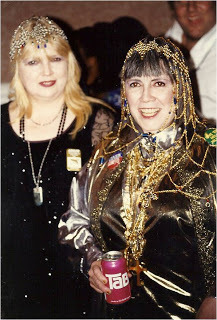
S. I am still in the process of forming the author panels with some authors who have not yet confirmed. I was told that some publishers are not so quick to commit due to the writer not being as huge as Anne Rice. It was exciting to hear that Anne Rice confirmed she would be at the Ball and after we found the place for the Author Social on Thursday, she confirmed not only that she was coming, but that her publisher Vicky Wilson would attend as well! A lot has to be confirmed when holding a four day event. We are using the same hotel and venue for the Ball but with the New year, Mardi Gras and the Superbowl all within weeks of each other, it was hard to get everything confirmed. More clubs and big charity events
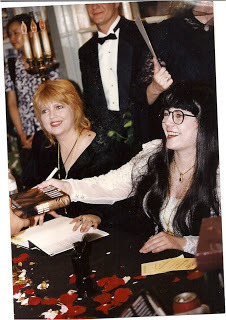 from South Africa! Another is stationed in Afganistan now after completing tours in Iraq and will get out in September. Really the best part of this is meeting all the authors and hearing their stories. I could not ask for more. I am thrilled to meet them all.
from South Africa! Another is stationed in Afganistan now after completing tours in Iraq and will get out in September. Really the best part of this is meeting all the authors and hearing their stories. I could not ask for more. I am thrilled to meet them all. H: How do people reach you if they want to become involved in any or all of your projects?
S. Our website is www.arvlfc.comand I can be reached by emailing me at [email protected]. I answer the emails and send out the memberships and have had local people help with this. It is a big job and without our webmistress and many extra helping hands that work tirelessly and contribute ideas and solutions, I could not make these events happen. We also communicate on Facebook and will be posting when we meet in case local people want to become a part of our staff. We can always
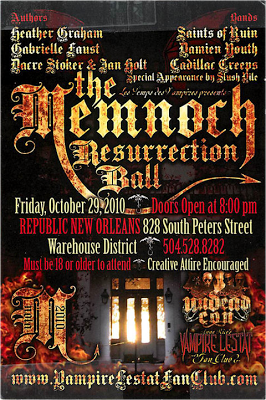 use a blood infusion!
use a blood infusion!More about the Ball: The theme for the Ball this year is Lestat's Reunion Ball celebrating the return of Anne Rice to New Orleans and her participation in the festivities. There will be special presentations and a Q&A at the Ball. Our musical entertainment will be planned and hosted by violinist Paul Mercer with Jill Tracy as Master of Ceremonies. Costumes are encouraged but not required, 18th century theme this year. We will also have our signed book raffles that will benefit St. Alphonsus Church. The Author Meet and Greet titled "An Evening with the Angels and Saints of St. Alphonsus Church" will highlight the historic church's need for our help to save the art and history of this Church of the Irish that is directly across the street from the German Church, St. Mary's Assumption. You can read more about the history of these two churches at www.stalphonsusneworleans.com.
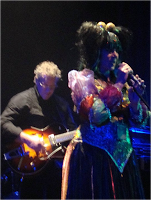 Please visit our website, www.arvlfc.com, or our facebook page for more updates on our festivities and participants
Please visit our website, www.arvlfc.com, or our facebook page for more updates on our festivities and participantsH. Thanks, Suzie. I can tell people with all my heart that your ball and con are great! I did have the pleasure of being a speaker and I’m one of the people trying to fix their schedule to get back this year. Our Slushpile band played the ball one year and it was a great time!Now, if you can’t make October and you can make December, there’s another con I’ll tell you about, Writers for New Orleans.But that’s for another day!
Published on April 04, 2013 00:03
April 2, 2013
30 Days of Why I Love New Orleans - Day 9
Food! Glorious Food!
New Orleans is a city known for its cuisine. If I were to blog for three hundred days instead of thirty, I couldn’t possibly get to all the wonderful places you can go to eat in this culinary city. So, to write this today, I’ve thought about my favorite places and asked friends and family to give me their spots of absolute culinary delight. You may have favorite places that I won’t get to, so, please, let me know when I’ve missed an absolute must!
Sometimes, I must admit, I personally have a little trouble making sure I don’t order food that’s too spicy for me in New Orleans. (My parents were Scottish and Irish; pizza was this rare and tasty treat in our house and I think I was seventeen when that arrived on the home table!) But if you have such a tender palette too, I will give you fair warning--be
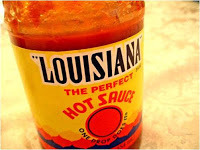 careful and ask for mild offerings. If you’re into spicy, eating in NOLA will be close to heaven.
careful and ask for mild offerings. If you’re into spicy, eating in NOLA will be close to heaven.Connie’s husband, Al, once told me that a gumbo was mild. My mouth was still on fire the next morning!
Most of the world, however, can handle spice better than I.
And because the city is really huge and there are so, so, so many restaurants to choose from, I’m going to stay in the French Quarter—all easy walking distance from anywhere in the French Quarter—except for my last.
We’ve already touched on the subject of Café du Monde; that’s for café au lait and beignets and people watching. And I’ve mentioned the hamburgers and to die for potatoes at Port of Call.
So here, I’ll start with K-Paul’s Louisiana Kitchen. (416 Chartres Street)
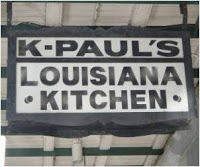
The master behind the restaurant is Paul Prudhomme who became famous—even among the already famous chefs of the world.
I’ve been lucky enough to talk with him several times at the restaurant. He is a charming and gracious man. The restaurant can get really crazy, so it’s best to call ahead for a reservation; if you don’t, you can try dining early or late. Paul Prudhomme is really responsible for introducing the concept of “blackened” food to a large portion of the world.
The menu changes constantly and yet some dishes you’ll find frequently enough. What is done there with shrimp and grits
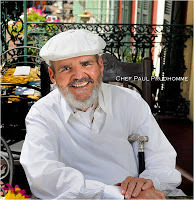 should be part of the dining delight of heaven. His chefs prepare equally wonderful tenderloin; crawfish, naturally. (Crawfish etouffee, oh yes!) For dessert, you have to try the bread pudding. Okay, just kidding; you don’t have to. I happen to love bread pudding. I also love the way that cute little food caricatures tell you about different recipes on the walls.
should be part of the dining delight of heaven. His chefs prepare equally wonderful tenderloin; crawfish, naturally. (Crawfish etouffee, oh yes!) For dessert, you have to try the bread pudding. Okay, just kidding; you don’t have to. I happen to love bread pudding. I also love the way that cute little food caricatures tell you about different recipes on the walls. Chef Paul Prudhomme was the youngest of thirteen children—imagine! He learned to cook with his mom, and I figure she must have spent a lot of time in the kitchen. I raised five children and feeding that much smaller number was a daily challenge. She taught him about fresh ingredients, and he holds to the freshest ingredients to this day. He’s acknowledged by culinary experts as being THE man to bring the distinctive cuisine of his native home to the American people; you can his wonderful spices on line and in specialty shops around the country. (Professional and amateur gourmets in all fifty states and twenty-five other countries treasure his offerings!) He has taught us all about gumbo and tasso and Andouille sausage and so much more! The restaurant is pleasant, there’s a courtyard, the staff is friendly—and it’s really a great experience all way round. I love coming here. It was also a privilege meeting him; he was a lovely man.
Next up, to me, is Mr. B’s. (201 Royal Street) Mr. B’s has a salad I really love, great
 gumbo, fresh bread, delights that are local, some spicy, some not. They’re open for lunch and can get very crowded so again, reservations are suggested but I’ve walked in off the street many a time. It’s busy, bustling, and delicious. It’s right across the street from the Hotel Monteleone, convenient and easy when we’re putting on Writers. They serve up a bloody Mary that will shock you to life and also whip up a blood orange Margarita that is fresh and delicious. Somehow, in NOLA, the coffee is always the best to me. There’s a jazz brunch on Sundays which is always entertaining.
gumbo, fresh bread, delights that are local, some spicy, some not. They’re open for lunch and can get very crowded so again, reservations are suggested but I’ve walked in off the street many a time. It’s busy, bustling, and delicious. It’s right across the street from the Hotel Monteleone, convenient and easy when we’re putting on Writers. They serve up a bloody Mary that will shock you to life and also whip up a blood orange Margarita that is fresh and delicious. Somehow, in NOLA, the coffee is always the best to me. There’s a jazz brunch on Sundays which is always entertaining.Quick and tasty and right on Decatur Street (near Jackson Square, the river, mule-driven carriages and more) is Tujague’ (823
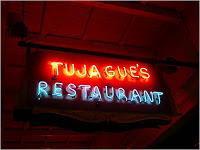 Decatur Street.) The restaurant claims to be the second oldest in the city and has been serving up Creole food since 1856. Guillerme Tujague came to America from France in 1852 and began by serving breakfast. The building itself was once a Spanish armory. Easy, pleasant, a nice taste of the city, and reasonable in price.
Decatur Street.) The restaurant claims to be the second oldest in the city and has been serving up Creole food since 1856. Guillerme Tujague came to America from France in 1852 and began by serving breakfast. The building itself was once a Spanish armory. Easy, pleasant, a nice taste of the city, and reasonable in price.Another fun restaurant is Maspero’s (440 Chartres Street.) The building was erected in 1788. It was a coffee house where the famous met at one time, including the Lafitte brothers and Andrew Jackson—before the Battle of New Orleans. Living
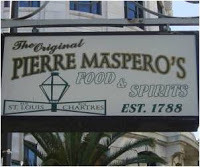 history, once again. There’s a nice casual air here as the staff serves up Cajun cuisine.
history, once again. There’s a nice casual air here as the staff serves up Cajun cuisine. 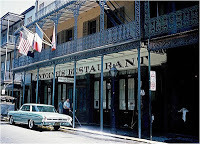 We’ve mentioned the second oldest restaurant, so now the first—Antoine’s. Antoine Alciatore came from Marseille. In 1840 he opened a rooming house or pension, naturally, with food to please and attract the visitor. The restaurant has been serving delicious food ever since. President Roosevelt once came here for lunch—you can come for lunch or dinner. Antoine’s continues to offer fine dining that is still
We’ve mentioned the second oldest restaurant, so now the first—Antoine’s. Antoine Alciatore came from Marseille. In 1840 he opened a rooming house or pension, naturally, with food to please and attract the visitor. The restaurant has been serving delicious food ever since. President Roosevelt once came here for lunch—you can come for lunch or dinner. Antoine’s continues to offer fine dining that is still
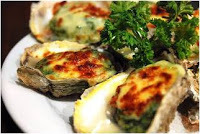 remarkably casual and friendly. You can see old photos on the walls and yet be charmed by the tablecloths and excellent service. It’s a lovely place to celebrate something special! Oysters Rockefeller are a specialty; they were first served here. (713 St. Louis Street)
remarkably casual and friendly. You can see old photos on the walls and yet be charmed by the tablecloths and excellent service. It’s a lovely place to celebrate something special! Oysters Rockefeller are a specialty; they were first served here. (713 St. Louis Street)The Court of Two Sisters is an excellent choice for a jazz brunch (or other dining!) The courtyard is lovely, the music divine, and the buffet long and filled
 with choices. (613 Royal Street) It’s named for two sisters, Emma and Bertha, who once owned a “notions” shop here—current owners are not related. But, of course, it’s a beautiful, historic, and certainly haunted building!
with choices. (613 Royal Street) It’s named for two sisters, Emma and Bertha, who once owned a “notions” shop here—current owners are not related. But, of course, it’s a beautiful, historic, and certainly haunted building! 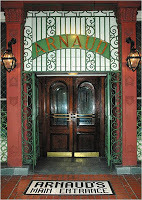
Arnoud’s (430 Dauphine Street) and Brennan’s (417 Royal Street) are both famed and elegant and offer wonderful food. A comparatively new choice among these long esteemed establishments is NOLA—Creole cuisine with a bit of a modern flair. (534 St. Louis Street) I’vereally enjoyed NOLA every time I've been.
For a great sandwich? A shrimp po-boy or the like? I recommend the Acme Oyster House. There can be quite a line at lunchtime. That’s because it’s reasonable and the food is very good. You can find it at 724 Iberville Street.
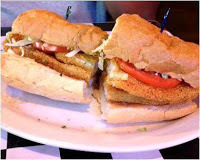

I didn’t set out to list restaurants—you can find a list anywhere and here’s something that’s great about the city—it’s actually hard to find a bad restaurant. I’m going to mention
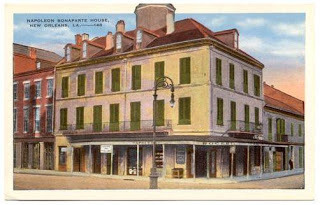 Napoleon House because it’s old and fun and in a building that was really erected with the hopes that Napoleon Bonaparte would come to New Orleans in his exile. We all know that didn’t happen—Napoleon remained on Elba where he passed away. Napoleon House remained-Napoleon House. Like many places, it has a great courtyard. It was really erected for Nicholas Girod in 1814-he was the man who sympathized with Napoleon
Napoleon House because it’s old and fun and in a building that was really erected with the hopes that Napoleon Bonaparte would come to New Orleans in his exile. We all know that didn’t happen—Napoleon remained on Elba where he passed away. Napoleon House remained-Napoleon House. Like many places, it has a great courtyard. It was really erected for Nicholas Girod in 1814-he was the man who sympathized with Napoleonand actually offered the deposed emperor the place if he came to New Orleans. The atmosphere here is fun and breezy. (500 Chartres Street)
All of the restaurants in historic buildings are proud of their history—often, you’ll find it on the menu and if you feel that you aren’t getting the whole story, ask your server. He or she will be glad to help you.
Muriel’s offers up just about everything, in my opinion. The food is delicious; there’s
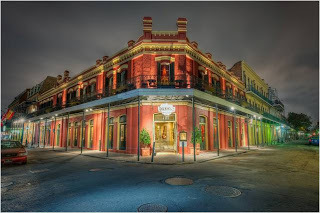 often a three piece jazz band playing. The building is charming and haunted. Once, for Writers, Helen Rosburg hosted a party here. Everyone came in antebellum dress and we had the entire second floor and used one room for old time photographs (taken by amazing mixed-media artist friend Lynn Sanders! Check out her work!) and we played charades
often a three piece jazz band playing. The building is charming and haunted. Once, for Writers, Helen Rosburg hosted a party here. Everyone came in antebellum dress and we had the entire second floor and used one room for old time photographs (taken by amazing mixed-media artist friend Lynn Sanders! Check out her work!) and we played charades in another room and set one aside for tarot and palm readings. The night was wonderful
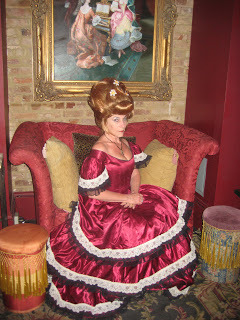 and I’m ever grateful to Muriel’s, and yes, I’ll always be partial. But, the wonder of dining at Muriel’s isn’t something you have to trust me about—ask anybody. Of course, it’s haunted. Balconies are beautiful and overlook Jackson Square! (801 Chartres Street)
and I’m ever grateful to Muriel’s, and yes, I’ll always be partial. But, the wonder of dining at Muriel’s isn’t something you have to trust me about—ask anybody. Of course, it’s haunted. Balconies are beautiful and overlook Jackson Square! (801 Chartres Street) 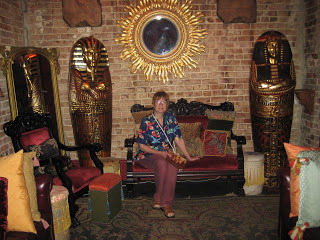
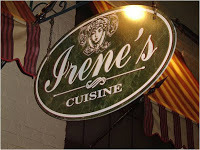 There are charming coffee shops, bars, little alleyway places, and tea shops just about everywhere.
There are charming coffee shops, bars, little alleyway places, and tea shops just about everywhere.You could also check out Irene's (lovely old fashioned feel and delicious food!) Or the Alpine—bread pudding that melts in your mouth. Or . . . .
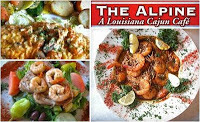 Like I said, hard to go wrong.
Like I said, hard to go wrong. The one restaurant I will talk about that’s out of the Quarter is in the Garden District. (1403 Washington Avenue) I’ve mentioned it before but it deserves a double-take. I’m referring to Commander’s Palace. Several stories, a garden, a terrace . . . wonderful salads, a bit of that amazing casual elegance that’s so charming, and entrees that are delicious. If you’re looking for a really nice afternoon, walk the Garden District and see some of the exquisite mansions, stop by the Garden District Book Store, feel the atmosphere of Lafayette Cemetery and marvel at the “city of the dead”—and then dine at
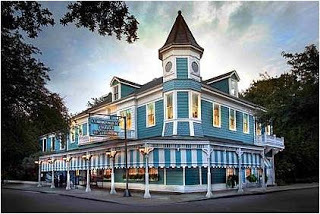 Commander’s Palace.
Commander’s Palace.New Orleans truly offers so much in the way of dining. Name an ethnicity, and you’ll find it somewhere. But if you’re going for a real taste of New Orleans, you can check out a few that I’ve mentioned here.
Oh, one last! Feel like a peanut but
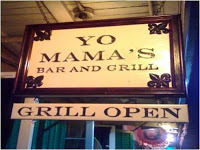
Published on April 02, 2013 15:08
April 1, 2013
30 Days of Why I Love New Olreans - Day 8
The Audubon Aquarium of the Americas

For me, diving is one on the greatest experiences I’ve ever enjoyed. And, as a diver, I tend to love the oceans and all things sea life. New Orleans does offer one of the most wonderful aquariums I’ve ever seen.
It’s easy to get to. It’s right on Canal Street at the Mississippi River. Seriously, head toward the river while you’re on Canal and you can’t miss it.
The aquarium was hard hit when Katrina went through the city; a generator went
down that caused it to lose a great deal of its marine life. I was lucky to be in town for the grand reopening in 2006 and it was quite an experience to be there. The place was thronged, of course, and still, all were in great spirits and ready to ooh and aah about the fantastic work that had been done to bring it back.
The exhibits concentrate on the Gulf of Mexico and the Caribbean but you never
 really know what you’re going to see. One special exhibit that held me rather spellbound was one that I normally might have shrugged over—it was on jellyfish. As a diver, I’m not all that fond of jellyfish. They sting like a son-of-a-gun and hurt like hell. But watching them through the glass was like seeing something out of a fantasy novel-turned-movie. They were really beautiful.
really know what you’re going to see. One special exhibit that held me rather spellbound was one that I normally might have shrugged over—it was on jellyfish. As a diver, I’m not all that fond of jellyfish. They sting like a son-of-a-gun and hurt like hell. But watching them through the glass was like seeing something out of a fantasy novel-turned-movie. They were really beautiful. There are over five hundred specimens of marine life to be found here.
There’s a tunnel you can walk through that makes it feel like you’re diving while you remain perfectly dry. It takes you through a Caribbean reef. You can view rays—animals I do love!—and angelfish and all kinds of great creatures that you would see if you were diving or snorkeling in the Caribbean. Sources tell me that the tank is 132,000 gallons.
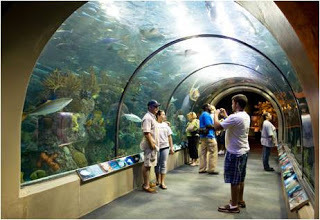
They say that water is soothing; many people believe that having an aquarium in a doctor’s office is calming for patients as they wait. Naturally, being in the water with a killer creature might not be calming, but watching them from the safety of an acrylic dome is pretty cool. I’m a Pisces, so maybe there’s something true in the horoscope, because I do love water. But if you even like the water, sea creatures, or coming close to other habitats, you can’t help but love the aquarium!
Besides the reef, you can see a Mississippi River and Delta exhibit with catfish, gar, turtles—and a white alligator. If you’re not going to make it out to a bayou, this is the next best thing. Better, maybe. These creatures are not lurking in the depths; they’re there for you to see. No bug bites here. Now,
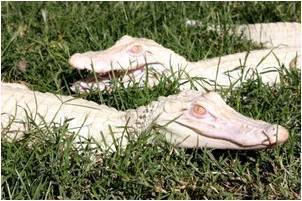 I’m from Florida, so it’s not as if I haven’t seen a number of alligators—even white ones. But I especially enjoy this exhibit, maybe because it does feel a little bit like home.
I’m from Florida, so it’s not as if I haven’t seen a number of alligators—even white ones. But I especially enjoy this exhibit, maybe because it does feel a little bit like home. Something of great interest to those who want to know more about our ecosystems and the working of an oil rig is the exhibit with--an oil rig. It's a replica off-shore oil rig complete with all the marine life that would swim around an oil rig out in the Gulf. You see sharks, tarpon, sting rays, turtles and more and get something of an idea of what being out on a rig would be like.
Want to get up close and personal with a piranha? Hm. Well, I don’t, not
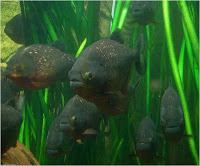 really—but I do enjoy seeing them in the aquarium’s Amazon Rainforest exhibit! You can get a real sense of where they live and what it’s like in an Amazon rainforest. There are macaws, too, squawking away, along with a seriously big anaconda and other animals.
really—but I do enjoy seeing them in the aquarium’s Amazon Rainforest exhibit! You can get a real sense of where they live and what it’s like in an Amazon rainforest. There are macaws, too, squawking away, along with a seriously big anaconda and other animals. Seriously, there are so many exhibits! And all of them really nicely set out so that walking through, you find interest in things you didn’t know you were interested in!
Want to know more and enjoy movies? Naturally, they have an IMAX theater offering all kinds of intriguing fare
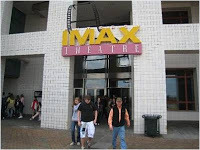 throughout the day on the world of water and the beings that reside in it, around it, or because of it! (The screen is five and a half stories high.)
throughout the day on the world of water and the beings that reside in it, around it, or because of it! (The screen is five and a half stories high.) The aquarium is naturally far more than kid friendly. Tiny to teenage, they can find entertainment at the aquarium. There’s an Adventure Island for little ones—hey, it’s NOLA. They can explore a pirate ship. There’s also a touch-pool for the kid in all of us with friendly rays, so I say take a look at Adventure Island with or without a kid as an excuse. I’ve been here with my little nephews and I’ve loved seeing everything through their eyes. With or
 without little ones, it’s simply a great aquarium.
without little ones, it’s simply a great aquarium. Sea otters! Lord, sea otters! I love them—there as cute as they can be. No, I have not tried to steal one. But are they fun to watch!
Penguins? Yes, they’ve got them!
Hungry? Naturally, they have a food court with different offerings. Want a party? That can be arranged.

Want to really, really explore and spend a whole bunch of time there? Ah, but you’re with someone who isn’t quite as fish-crazy as you are.
No problem. A short distance away is Harrah’s Casino. I tremble to admit that the bright lights have lured me a few times, but, say your friend isn’t a gambler. He/she can head to the nearby Shops of Canal Place.
Maybe your friends are bug maniacs. Even if not, nearby is the Audubon Insectarium. It’s an award-winning entomology museum and you can see things that creep and crawl, fly, bite, sting,
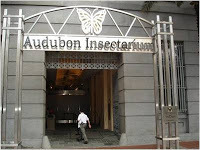 slither—and help keep our ecology on track! You can find the Audubon Insectarium very close—at 423 Canal Street—in part of the old U.S. Custom House. (Circa 1881) All kinds of insects can be found here and—if you’ve the mind!—you can even learn about insect cuisine from a specialized chef!
slither—and help keep our ecology on track! You can find the Audubon Insectarium very close—at 423 Canal Street—in part of the old U.S. Custom House. (Circa 1881) All kinds of insects can be found here and—if you’ve the mind!—you can even learn about insect cuisine from a specialized chef!I happen to be a little more partial to sea creatures, but you’ll be surprised just what you can learn about insects here. I highly recommend both for those traveling with children—and for those who simply love sea creatures and river beings, etc., and/or—bugs!

Published on April 01, 2013 22:06
March 31, 2013
30 Days of Why I Love New Orleans - Day 7
Mardi Gras World New Orleans, is, of course, world famous for its Mardi Gras celebration.
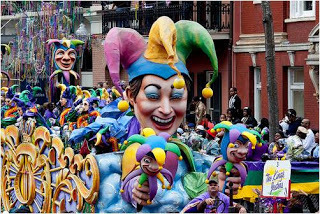
And Mardi Gras is one of those occasions that’s absolutely amazing. It’s other things, too, of course. Wild, whacky, fun . . . and the city becomes incredibly expensive and crowded and busy. The best way to see Mardi Gras is from a float, but then, everyone can’t afford a float and come up with the king and the queen and the court and the costumes and price and all that goes with it.
We’ve all heard that people “flash” for beads to be thrown to them from the floats. I’ve never quite gotten this concept since anyone can buy a massive bag of beads for almost nothing, but . . . hey, catching them is part of the fun. Young people will flash and throng the streets and it’s crazy.
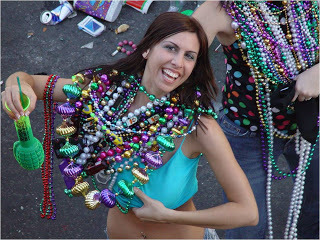 Mardi Gras originated in Europe in the seventeenth and eighteenth centuries. A Catholic society gave up eating meat for the period of Lent and thus the day before giving up meat first became known as “boeuf gras,” or “fatted calf.” That meant, kiddies, get it all in before you have to give it all up. Mardi is the French word for Tuesday, so Mardi Gras became the celebration before Ash Wednesday.
Mardi Gras originated in Europe in the seventeenth and eighteenth centuries. A Catholic society gave up eating meat for the period of Lent and thus the day before giving up meat first became known as “boeuf gras,” or “fatted calf.” That meant, kiddies, get it all in before you have to give it all up. Mardi is the French word for Tuesday, so Mardi Gras became the celebration before Ash Wednesday. Rio celebrates massively, and “Carnivale” in Venice is equally huge. Trinidadians get really carried away, too. But New Orleans is our biggest and best event in the United States. Well, of course!
It was on March 2, 1699, when the French-Canadian explorer Jean Baptiste Le Moyne Sieur de Bienville made his way to a little spit of earth that was about 60 miles south of New Orleans. He named it "Pointe du Mardi Gras"–because he and his men figured out that they had come to the area right when Mardi Gras and Lent were upon them. So tradition goes back—way back! (If you’re in the Quarter, you will find yourself on Bienville Street at some time; the great man will not be forgotten!)
And the people were French, for God’s sake! They had their customs. And they had, and still have, an amazing flair for beautiful things.
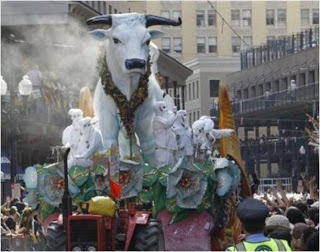 This wonderful custom has come down through the ages. At first, balls happened—which eventually became the grand balls of today. Then “Rex” headed a parade down the street with a real bull.
This wonderful custom has come down through the ages. At first, balls happened—which eventually became the grand balls of today. Then “Rex” headed a parade down the street with a real bull. If you do come for Mardi Gras, a great thing to do is plan well ahead of time and rent a balcony on Bourbon Street—you’ll be high above the crowd, watching and enjoying. (Have to admit here; it’s not always a good time to be on the street. Some people party a little too hearty and there’s sometimes a fair amount left on the streets by those who over-imbibed and became nauseated. Yep, throw up, guys!)
But, hey! You may not mind to be part of the revelry!
Now we all know that Mardi Gras itself happens only once a year. And New Orleans is a great place to visit year round. Yes, summer is hot. But since I’m from Miami, it’s not
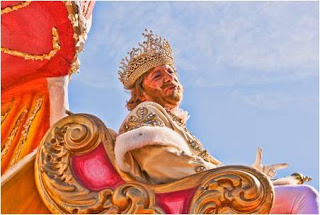 like it really bothers me. And, hey, I’ve been in New York and Virginia in the summer on days when the heat soared higher than it did down further south.
like it really bothers me. And, hey, I’ve been in New York and Virginia in the summer on days when the heat soared higher than it did down further south. But weather is not the point. Nor is an exact date. In fact, the point is that we’re looking at a venue where one can go at any time.
You can “see” something of Mardi Gras all year round.
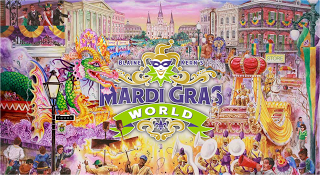 That’s because of Mardi Gras World.
That’s because of Mardi Gras World. Artists have always amazed me, probably because I don’t have an artistic bone in
my body. What they can create is mind boggling. Truly, there is little quite so spectacular on that plain than the floats that are created for the Mardi Gras parades—unless it’s the
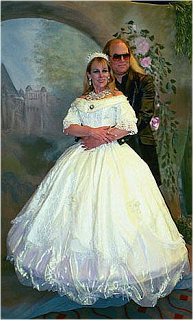 costumes worn.
costumes worn.Since 1947, the Blaine Kern Studios have been producing the amazing floats you see in the Mardi Gras parades. Mardi Gras World affords everyone a glace at what goes on to create the fantastic floats in a venue that is beautiful, artistic -- incredible!
At Mardi Gras World, you can see old floats and new. You can see the artistry that goes into the creation of the floats. Themes abound and you can learn more about the history of the floats themselves, the parade, and Mardi Gras.
They have a shuttle that runs around the city on appointed rounds to bring people to and from the city and if you’re anywhere fairly central, it’s an easy hop over.
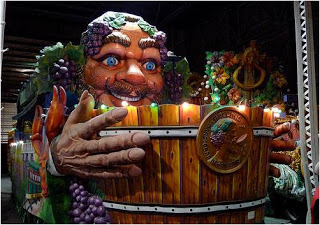
From the detailed to the massive, you can see the work of the artists who create the magic of a Mardi Gras parade. You can be beneath a “star-lit” sky and feel that you’re part of a fantasy world.
You almost feel as if you’ve been to Mardi Gras! (But then again, remember, there are parades in many of the parishes and cities surrounding NOLA, and if you do happen to be there for Mardi Gras, don’t miss “Barkus!” For my animal loving friends, that’s
 a dog parade and it occurs a day or so before the big parades. Pure fun!)
a dog parade and it occurs a day or so before the big parades. Pure fun!) But again, no matter what the season, you can—and should!—visit Mardi Gras World. There’s something new there, too, that just opened in 2012. The Café. It sits right on the river and serves up local specialties at very reasonable prices. You can see the specialized fantasy created by man and then the fantastic created by mother nature—the “Big Muddy” or the “Mighty Mississippi” as you enjoy a cocktail or red beans and rice, jambalaya, or gumbo or many other entrees.
Just watching the river, with Mardi Gras World in the background, is a true New Orleans experience.
If you go . . . their shuttle stops at 20 different places in
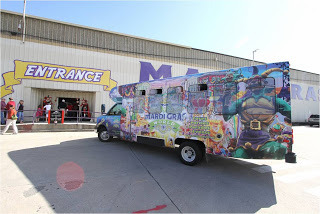 and around the Quarter and downtown and runs a continual loop. The official address is 1380 Port of New Orleans Place. You’re not far from the Quarter; they are located down at the end of Henderson Street in the Central Business District.
and around the Quarter and downtown and runs a continual loop. The official address is 1380 Port of New Orleans Place. You’re not far from the Quarter; they are located down at the end of Henderson Street in the Central Business District.
Published on March 31, 2013 23:20
March 29, 2013
30 Days of Why I Love New Orleans - Day 6
The Haunted Mortuary
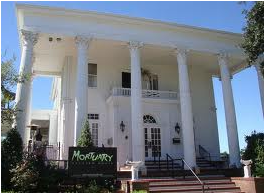 Chills, thrills, screams, yes! This beautiful old place was built as a home. Then it did, historically, become a mortuary; the embalming rooms remain today.
Chills, thrills, screams, yes! This beautiful old place was built as a home. Then it did, historically, become a mortuary; the embalming rooms remain today.I’m particularly fond of the Haunted Mortuary because we were able to see it in its infancy, before it was really decided just what it was going to be. There was work being done the first time we came; while failed businesses over the years—and Hurricane Katrina!—had taken their toll on the beautiful mansion, they hadn’t done her in. She’d recently been purchased by Jeff Borne, the owner of PSX Audio/Video Technologies. He wanted to build a haunted attraction that could rival the best.
I think he achieved his goal.
There were plans for it to house a paranormal research facility—which it did for many years. There was a wonderful upstairs room with an octagonal table where cards could be read. People could be tested to find out if they did have psychic abilities.
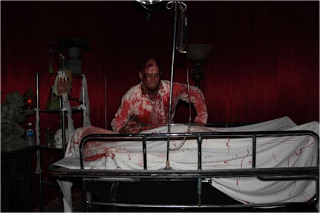
The paranormal research people have moved on to new facilities in Las Vegas but the Haunted Mortuary—elegant in its gruesomeness—lives on!
The first time I came when it was set up with the “haunted” house in the basement, I was really there to be upstairs to talk to the para-psychology group and it was daytime. But, they were set-up below for the haunted house to begin for the Halloween season.
Even by light, oh . . . !
They do a fantastic job here!
 A year or so ago when we were doing our Writers for New Orleans conference on the Labor Day Weekend, the management was kind enough to allow our group in for a private “early-bird.” It was just our group—and I promise you, we stayed close!
A year or so ago when we were doing our Writers for New Orleans conference on the Labor Day Weekend, the management was kind enough to allow our group in for a private “early-bird.” It was just our group—and I promise you, we stayed close!It’s now billed as one of the “most actively haunted” houses in the United States. Whether real ghosts have taken up residency or not, I do know that as a Halloween haunted house, it’s one of the most frightening I’ve ever seen. Live actors enhance the tingles that will seize you.
We brought in our own catering that night with the blessings of the management the house was not fully up—it wasn’t due to open to the public for another week. Connie was unaware that many of the creatures were motion activated. The basement level (where the embalming went on) is on the tour—it’s also where you can bring heavy things on through to the kitchen. As Connie entered from the backside with our trays of sandwiches and
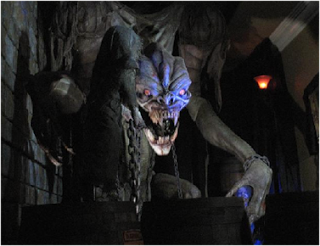 munchies, she inadvertently walked right by a giant, creepy monster with huge skeletal arms and fingers and dripping moss. As she moved, the light came on—the monster moved and cackled—and Connie screamed, jumped a mile high—and sandwiches went flying.
munchies, she inadvertently walked right by a giant, creepy monster with huge skeletal arms and fingers and dripping moss. As she moved, the light came on—the monster moved and cackled—and Connie screamed, jumped a mile high—and sandwiches went flying.I’ve seldom been so scared by such a facility—nor have I laughed harder!
They have simply done a spectacular job with the place. Rooms are truly historically tinged by the past and therefore, perhaps, they already offer a sense of that long time gone that we can no longer touch. Maybe there’s a faint whimper left on the air, the tears of a survivor saying goodbye to a loved one. The effects are worthy of a good Hollywood flick and the actors have a nice zeal for their jobs.
The Haunted Mortuary is a true Victorian mansion, grand in its scope. It sits at
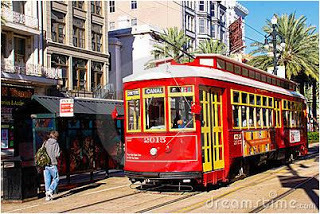 4800 Canal Street (out of the Quarter!) but can be reached easily by car or streetcar. It was built in 1872 by a woman named Mary Slattery who surely imagined that in the decades to come, her children and grandchildren would live in the house. But dreams are seldom to be—in 1905 she sold the home, and in 1928, it was sold again—this time to become a business.
4800 Canal Street (out of the Quarter!) but can be reached easily by car or streetcar. It was built in 1872 by a woman named Mary Slattery who surely imagined that in the decades to come, her children and grandchildren would live in the house. But dreams are seldom to be—in 1905 she sold the home, and in 1928, it was sold again—this time to become a business.By 1930, new owners were advertising the house as the P.J. McMahon and Sons Undertaking. In 1933, the garage entry was built—that same entry that nearly scared Connie to an early grave! The concept at the time was that a funeral home should have all the comforts of home, and, of course, give comfort to the loved ones left behind.
Eventually, the funeral business gave way, as many will. During the years that followed, other interests envisioned the house in many ways. But it wasn’t until it became the Haunted Mortuary—and wonderful and tremendous work went on!—that the gorgeous place was really saved.
Today, check out the venue when you’re in the city. It’s available for private parties, to film studios—and even for children’s birthday parties.
But, when Halloween rolls around . . . .
I promise you, it’s terrifying. Yes, I’m a chicken—but I saw it scare big, grown men. Even big, grown men in law enforcement.
Oh—just by happenstance, the Haunted Mortuary sits next to an old Jewish
 cemetery. You can look out the windows and see as the moon shines down on the graves next door.
cemetery. You can look out the windows and see as the moon shines down on the graves next door.I was able to host my party there and it was quite a feeling, standing at the door in Victorian mourning, waiting for our guests to arrive. I was left alone in what was once a “viewing” room; I admit, I kept listening for people in the nearby bar area as we set up for our friends to come.
Once, in the early states, I had asked a friend who worked in parapsychology more about the ghosts; I loved her answer. They might not all have died at the mortuary, and they might not have been at the mortuary for a viewing. But New Orleans was one of the most haunted cities in the world.
Bourbon Street was riddled with ghosts.
It’s kind of like Field of Dreams in her mind.
If you build it, they will come!
There must be something. Paranormal research groups from across the country have come here on their expeditions. You can arrange to take tours and learn what spirits remain behind.
The displays are wonderful. Cobwebs and skeletal beings . . . and sometimes, you
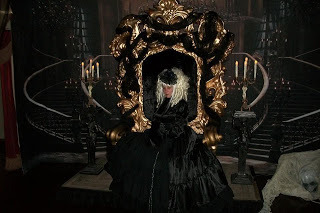 may not be sure if they will or will not move . . . .
may not be sure if they will or will not move . . . .Oh, and there’s a huge marvelous black chair decked out in a most creepy fashion (see pic!) that can also make quite a change.
When the holidays roll around, Santa visits the Haunted Mortuary.
What’s black becomes red. Ho, ho, ho!
Yes, like New Orleans, the Haunted Mortuary can roll with the seasons of life!
Visit and see! Their website is hauntedmortuary.com!
Published on March 29, 2013 17:02
Thirty Days of Why I Love New Orleans - Day 5
Rounding the French Quarter The French Quarter , going clockwise, is bounded by the river, Canal Street, Rampart Street, and Esplanade. It’s a fantastic grid of historic buildings, shops, museums, hotels, bed and breakfast establishments and great places to eat. There are wonderful private homes, here, too, and apartments and all kinds of ways to stay for a visit—or forever!
There’s no way in a 1000 something word blog to really relate the wonder of the French Quarter to you, but I’ll try to hit a few highlights, going around that clock!
First, there’s the river. That’s where you can board the Steamboat Natchez. And it’s where you can look out and see the majesty of the Mississippi and understand the moniker
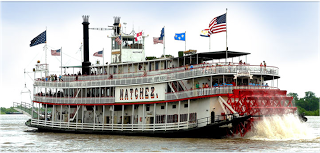 “Crescent City.” The water is river water, dark, sometimes turbulent, and deep—it also makes you understand the term “Mighty Mississippi.” Just to walk along the river is an experience. You can also catch the Riverfront Line streetcar here; it’s a fun thing to do if you just pick a destination, or hop on to ride out—and ride right back! The streetcars were operating sixty years before the electric lines that made a “trolley” come into being; in NOLA, they are still called streetcars! (There are three streetcar lines—the Riverfront, the Canal Street, and the St. Charles. They’re actually excellent for getting around!)
“Crescent City.” The water is river water, dark, sometimes turbulent, and deep—it also makes you understand the term “Mighty Mississippi.” Just to walk along the river is an experience. You can also catch the Riverfront Line streetcar here; it’s a fun thing to do if you just pick a destination, or hop on to ride out—and ride right back! The streetcars were operating sixty years before the electric lines that made a “trolley” come into being; in NOLA, they are still called streetcars! (There are three streetcar lines—the Riverfront, the Canal Street, and the St. Charles. They’re actually excellent for getting around!)

You’ll come upon the Aquarium of the Americas as you head to Canal Street; a truly remarkable facility with all manner of creatures. (Aquarium on another day!) The Shops at Canal Street are here—yes, on Canal Street. There are some different stores here—and some chains. But if you need something you can only get at a chain, here’s a convenient place! If you were to cross the street from the Aquarium and the mall, you’d be at Harrah’s, but, ahha! Across the street you are no longer in the boundaries of the French Quarter.
Say you walk up Canal side toward Rampart Street. You will pass some souvenir shops, hotels and restaurants. Most of them, even the national—you can get an Arby’s fix here—are housed in quaint buildings; different! If you walk along you’ll come to Rampart, and if you turn and walk along Rampart, you’ll find some restaurants, etc., but you won’t really be in the heart of the quarter which some say stretches really only from the Jackson Square area to Esplanade and Canal and then on up to Bourbon.
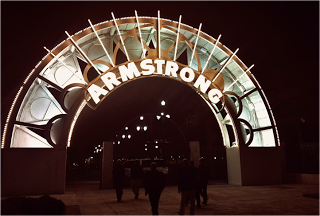 But you’ll be across from Armstrong Park and the neighborhood on which a TV series has recently been based—Treme. Wonderful people live here; it’s still not a good idea to wander at night.
But you’ll be across from Armstrong Park and the neighborhood on which a TV series has recently been based—Treme. Wonderful people live here; it’s still not a good idea to wander at night.
When you reach Esplanade, you’ll know it! It’s a grand avenue with a tree laden divider and there are grand mansions on either side. Now, like all else, a lot of these mansions now constitute what I consider to be living history. A beautiful structure may still be privately owned—or it may be a restaurant and shops downstairs and some apartments upstairs. If you like walking, this gorgeous tree-laden street is for you. I’ll also mention here
that it’s where you’ll find Port of Call—a bar/restaurant which serves up some of the finest
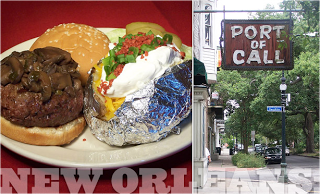 hamburgers and baked potatoes you’ll ever have. I’m serious—best baked potatoes. I’m assuming they come from Idaho and I could be wrong. I just know that they’re huge and delicious!
hamburgers and baked potatoes you’ll ever have. I’m serious—best baked potatoes. I’m assuming they come from Idaho and I could be wrong. I just know that they’re huge and delicious!
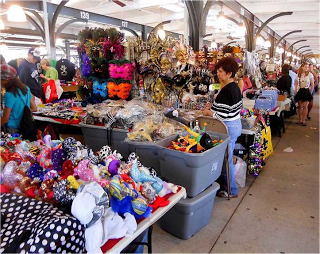 Keep on walking down and you’ll reach the French Market. You won’t be doing anything new; the French Market has been an institution since 1791. It’s a great place to go for all kinds of delicious things. Now, you keep walking, and you’ll be amazed at what you can buy. The area houses stalls that sell almost everything in the world.
Keep on walking down and you’ll reach the French Market. You won’t be doing anything new; the French Market has been an institution since 1791. It’s a great place to go for all kinds of delicious things. Now, you keep walking, and you’ll be amazed at what you can buy. The area houses stalls that sell almost everything in the world.
So, you’ve come back to the river. You’ll have passed some unbelievable places, good restaurants shops, all kinds of wonders. When you reach the end of the market and some of the cafes and shops that follow, you’ll be at Café du Monde.
This is truly an institution—many people say that if you just brush by NOLA, you must stop at Café du Monde. The menu is small and naturally, it’s famous for its delicious,
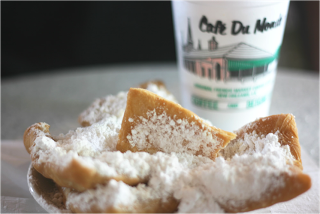 powdery beignets. (Word to the wise; I’ve done it—don’t wear black!) Of course, it’s not just the fabulous sugar treat that will draw you here, or the rich, dark coffee (hot or iced!) Sitting at Café du Monde is half the fun. You can find a table where you can watch the heart and throb of the city go on. The mule-drawn carriages that hike tourists around on all kinds of tours (history with or without vampires and ghosts and other-worldly creatures) line up in front of Jackson Square. Mules are here in NOLA because horses can’t stand the heat; the hearty mule does well! Artists set up there, and if you were walking on that side of the street, you could find yourself buying a colorful city scape as you head to catch a carriage. But at Café du Monde, you just watch it all. You have a view of the street performers—those who sing and play musical instruments, and those who pose as statues in different paint or appointments. Some are absolutely awesome in their ability to stand for hours on end without moving!
powdery beignets. (Word to the wise; I’ve done it—don’t wear black!) Of course, it’s not just the fabulous sugar treat that will draw you here, or the rich, dark coffee (hot or iced!) Sitting at Café du Monde is half the fun. You can find a table where you can watch the heart and throb of the city go on. The mule-drawn carriages that hike tourists around on all kinds of tours (history with or without vampires and ghosts and other-worldly creatures) line up in front of Jackson Square. Mules are here in NOLA because horses can’t stand the heat; the hearty mule does well! Artists set up there, and if you were walking on that side of the street, you could find yourself buying a colorful city scape as you head to catch a carriage. But at Café du Monde, you just watch it all. You have a view of the street performers—those who sing and play musical instruments, and those who pose as statues in different paint or appointments. Some are absolutely awesome in their ability to stand for hours on end without moving!
You’ll see the fortune tellers there as well; if you have the mind to, you can run across and have you palm read, or find out what the tarot cards have to say about your
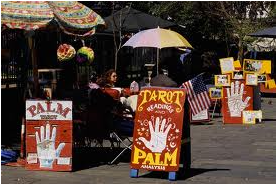 future.
future.
And, resting from your walk at a table at Café du Monde, you can look into Jackson Square and see—Andrew Jackson. He’s astride his rearing horse, hat in hand, ever watchful over the city he saved at the Battle of New Orleans. In the early days, Jackson Square was called Place d’Armes. It was a little more than mush and a field back then, a place where troops could drill, and where criminals might be seen in stocks –and where executions might be carried out.
Today . . . .
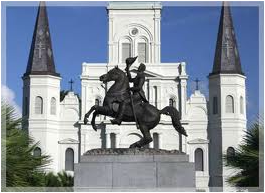
Don’t think about the executions! Enjoy General Jackson as he waves his hat, and wave back if you’ve the mind to do so.
It’s NOLA. People will think nothing of it!
There’s no way in a 1000 something word blog to really relate the wonder of the French Quarter to you, but I’ll try to hit a few highlights, going around that clock!
First, there’s the river. That’s where you can board the Steamboat Natchez. And it’s where you can look out and see the majesty of the Mississippi and understand the moniker
 “Crescent City.” The water is river water, dark, sometimes turbulent, and deep—it also makes you understand the term “Mighty Mississippi.” Just to walk along the river is an experience. You can also catch the Riverfront Line streetcar here; it’s a fun thing to do if you just pick a destination, or hop on to ride out—and ride right back! The streetcars were operating sixty years before the electric lines that made a “trolley” come into being; in NOLA, they are still called streetcars! (There are three streetcar lines—the Riverfront, the Canal Street, and the St. Charles. They’re actually excellent for getting around!)
“Crescent City.” The water is river water, dark, sometimes turbulent, and deep—it also makes you understand the term “Mighty Mississippi.” Just to walk along the river is an experience. You can also catch the Riverfront Line streetcar here; it’s a fun thing to do if you just pick a destination, or hop on to ride out—and ride right back! The streetcars were operating sixty years before the electric lines that made a “trolley” come into being; in NOLA, they are still called streetcars! (There are three streetcar lines—the Riverfront, the Canal Street, and the St. Charles. They’re actually excellent for getting around!)
You’ll come upon the Aquarium of the Americas as you head to Canal Street; a truly remarkable facility with all manner of creatures. (Aquarium on another day!) The Shops at Canal Street are here—yes, on Canal Street. There are some different stores here—and some chains. But if you need something you can only get at a chain, here’s a convenient place! If you were to cross the street from the Aquarium and the mall, you’d be at Harrah’s, but, ahha! Across the street you are no longer in the boundaries of the French Quarter.
Say you walk up Canal side toward Rampart Street. You will pass some souvenir shops, hotels and restaurants. Most of them, even the national—you can get an Arby’s fix here—are housed in quaint buildings; different! If you walk along you’ll come to Rampart, and if you turn and walk along Rampart, you’ll find some restaurants, etc., but you won’t really be in the heart of the quarter which some say stretches really only from the Jackson Square area to Esplanade and Canal and then on up to Bourbon.
 But you’ll be across from Armstrong Park and the neighborhood on which a TV series has recently been based—Treme. Wonderful people live here; it’s still not a good idea to wander at night.
But you’ll be across from Armstrong Park and the neighborhood on which a TV series has recently been based—Treme. Wonderful people live here; it’s still not a good idea to wander at night. When you reach Esplanade, you’ll know it! It’s a grand avenue with a tree laden divider and there are grand mansions on either side. Now, like all else, a lot of these mansions now constitute what I consider to be living history. A beautiful structure may still be privately owned—or it may be a restaurant and shops downstairs and some apartments upstairs. If you like walking, this gorgeous tree-laden street is for you. I’ll also mention here
that it’s where you’ll find Port of Call—a bar/restaurant which serves up some of the finest
 hamburgers and baked potatoes you’ll ever have. I’m serious—best baked potatoes. I’m assuming they come from Idaho and I could be wrong. I just know that they’re huge and delicious!
hamburgers and baked potatoes you’ll ever have. I’m serious—best baked potatoes. I’m assuming they come from Idaho and I could be wrong. I just know that they’re huge and delicious!  Keep on walking down and you’ll reach the French Market. You won’t be doing anything new; the French Market has been an institution since 1791. It’s a great place to go for all kinds of delicious things. Now, you keep walking, and you’ll be amazed at what you can buy. The area houses stalls that sell almost everything in the world.
Keep on walking down and you’ll reach the French Market. You won’t be doing anything new; the French Market has been an institution since 1791. It’s a great place to go for all kinds of delicious things. Now, you keep walking, and you’ll be amazed at what you can buy. The area houses stalls that sell almost everything in the world. So, you’ve come back to the river. You’ll have passed some unbelievable places, good restaurants shops, all kinds of wonders. When you reach the end of the market and some of the cafes and shops that follow, you’ll be at Café du Monde.
This is truly an institution—many people say that if you just brush by NOLA, you must stop at Café du Monde. The menu is small and naturally, it’s famous for its delicious,
 powdery beignets. (Word to the wise; I’ve done it—don’t wear black!) Of course, it’s not just the fabulous sugar treat that will draw you here, or the rich, dark coffee (hot or iced!) Sitting at Café du Monde is half the fun. You can find a table where you can watch the heart and throb of the city go on. The mule-drawn carriages that hike tourists around on all kinds of tours (history with or without vampires and ghosts and other-worldly creatures) line up in front of Jackson Square. Mules are here in NOLA because horses can’t stand the heat; the hearty mule does well! Artists set up there, and if you were walking on that side of the street, you could find yourself buying a colorful city scape as you head to catch a carriage. But at Café du Monde, you just watch it all. You have a view of the street performers—those who sing and play musical instruments, and those who pose as statues in different paint or appointments. Some are absolutely awesome in their ability to stand for hours on end without moving!
powdery beignets. (Word to the wise; I’ve done it—don’t wear black!) Of course, it’s not just the fabulous sugar treat that will draw you here, or the rich, dark coffee (hot or iced!) Sitting at Café du Monde is half the fun. You can find a table where you can watch the heart and throb of the city go on. The mule-drawn carriages that hike tourists around on all kinds of tours (history with or without vampires and ghosts and other-worldly creatures) line up in front of Jackson Square. Mules are here in NOLA because horses can’t stand the heat; the hearty mule does well! Artists set up there, and if you were walking on that side of the street, you could find yourself buying a colorful city scape as you head to catch a carriage. But at Café du Monde, you just watch it all. You have a view of the street performers—those who sing and play musical instruments, and those who pose as statues in different paint or appointments. Some are absolutely awesome in their ability to stand for hours on end without moving! You’ll see the fortune tellers there as well; if you have the mind to, you can run across and have you palm read, or find out what the tarot cards have to say about your
 future.
future. And, resting from your walk at a table at Café du Monde, you can look into Jackson Square and see—Andrew Jackson. He’s astride his rearing horse, hat in hand, ever watchful over the city he saved at the Battle of New Orleans. In the early days, Jackson Square was called Place d’Armes. It was a little more than mush and a field back then, a place where troops could drill, and where criminals might be seen in stocks –and where executions might be carried out.
Today . . . .

Don’t think about the executions! Enjoy General Jackson as he waves his hat, and wave back if you’ve the mind to do so.
It’s NOLA. People will think nothing of it!
Published on March 29, 2013 17:01



